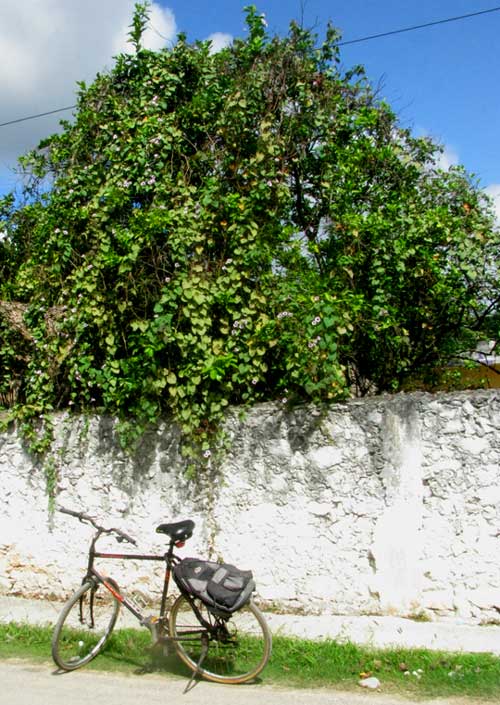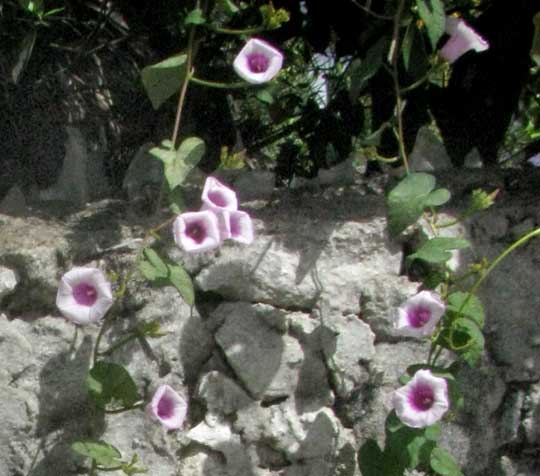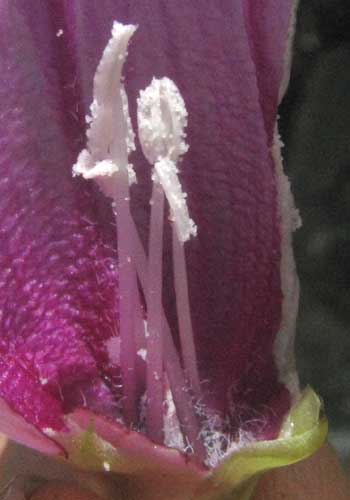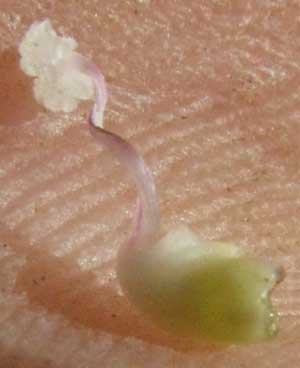Excerpts from Jim Conrad's
Naturalist Newsletter
from the February 12, 2012 Newsletter issued from Hacienda Chichen Resort beside Chichén Itzá Ruins; limestone bedrock; elevation ~39m (~128ft), N20.675°, W88.569°; central Yucatán state, MÉXICO
FLOWERING SWEET POTATO VINE
The tree overgrown with flowering vines shown below caught my eye:

A closer look at the vine's flowers and leaves is seen below:

I used to grow sweet potatoes back in Kentucky and Mississippi, so I recognized this as a Sweet Potato vine. Notice how some of the leaves are slightly lobed at their bases, and that the flowers' mostly white but purple-eyed corollas have especially broad tubes, plus notice the curious way the corolla rim folds back on itself. Most flowers in this family emerge in a twisting manner (they're "convolute" in the bud), and you can see the resulting flower's pleats and indications of its earlier twistiness, but these flowers open like lips that are made to pooch out into a pout. That's a little unusual.
Sweet Potato vines are IPOMOEA BATATAS, and are genuine morning-glories. Ipomoea is the morning-glory genus in the Morning-Glory Family. Knowing that the stigmas of Ipomoeas are spherical instead of elongated like in many other Morning-Glory Family genera, I opened a flower to confirm the ID, and saw what's shown below:

Those erect stamens of varying lengths look very morning-gloryish, but where are the female stigma, style and ovary? Several blossoms showed the same thing. Finally I dug way down into some stamen bases and found the quarter-inch thing (5mm) shown below:

Those are shriveled up, undeveloped female parts. The stunted stigma is at the top, left, the curly stem is a not-fully-formed style, and the greenish item at the lower right is an aborted ovary.
Then it dawned on me that the Sweet Potato plant has been selectively bred for so long that, like many important horticultural plants, it's lost some or all of its ability to reproduce sexually.
Moreover, this much-flowering Sweet Potato vine was clearly different from the tuber-producing vine I'd grown up North, which seldom flowered at all, and their leaf bases were much more likely to be angularly lobed. This was surely a cultivar developed for flowering, not producing big, sweet tubers.
In fact, on the Internet you can find plenty of pictures of gorgeously flowering Sweet Potato vines by searching on "flowering sweet potato." The most famous flower cultivar appears to be 'Blackie,' with very dark leaves and dark, somber flowers. I read that flowering sweet potatoes typically are sterile. The stunted female parts found in our blossoms are completely to be expected.